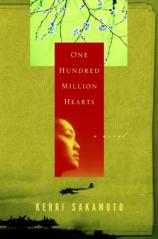One Hundred Million Hearts
Review
One Hundred Million Hearts
Kerri Sakamoto's second novel begins in first person: "During the
war my father learned to shoot a rifle, lunge with his bayonet and
march the perimeter of Okayama Second Middle School, knees high and
arms swinging."
The speaker is Miyo Mori, a nisei, "a Canadian-born
Japanese" living in Toronto and suffering an unnamed affliction
that makes her bones brittle and has left one side of her body
caved in. Her temple and chest are sunken, and she walks with a
limp. After her mother dies, Miyo's father, Masao, raises her
himself, sacrificing everything to care for his needy, demanding
daughter.
He remains the only person in her life, her sole caretaker, until
she meets David, a loving, if slightly patronizing, human resources
salaryman who becomes her lover. A few months after Miyo moves in
with David, Masao dies, and the secrets of his life and the
magnitude of his sacrifice for her reveal themselves: Not only was
he secretly married to a woman named Setsuko, but they had a
daughter Hana, whom he never even saw. Reeling from this news, Miyo
travels to Japan to meet Hana, an artist obsessed with the kamikaze
of World War II who disappears without warning for days on
end.
The concept of the kamikaze is central to the novel: Flying into
battle, they carried with them the wishes of their people for
glorious deaths. Theirs was an honorable sacrifice, and survival
was considered failure. Those kamikaze who returned to Japan ---
including, Miyo learns and finally accepts, Masao --- were marked
by shame and ridicule.
By this point, Sakamoto has switched from first person point of
view to second, from I to she. It's a poor technical decision ---
perhaps best explained by the fact that the first chapter was
published separately in Toronto Life --- but readers will
miss reading the story through Miyo's words and getting her direct
responses to these events.
This switch in perspective also reveals the lack of focus in the
story that follows. While intriguing and insightful, ONE HUNDRED
MILLION HEARTS often becomes detached and aloof without Miyo's
narration. And when Sakamoto leaves Miyo behind to recount the
reminiscences of Setsuko and a war criminal named Koji "Buddy"
Korada, the novel becomes muddled, mired in Japanese history and
slowing its pace considerably.
While flawed, ONE HUNDRED MILLION HEARTS still manages to portray
the nisei as trapped between Western and Eastern cultures,
defined by both but accepted by neither. The novel is at its best
when it follows Miyo, who cannot speak Japanese, in Tokyo and,
later, in Hiroshima, marveling at a world that is at once
frightening to her and familiar. Appearing Japanese, she manages to
blend into crowds only until she opens her mouth and speaks perfect
English.
At its own heart, the novel ably captures how much the world can
change in a single lifetime, such that the sacrifices of one
generation are incomprehensible to the next. That this theme
emerges from the shifting perspectives and anchorless narrative is
testament to Sakamoto's understanding of both Japanese and Canadian
cultures, and to her considerable talents as a writer.
Reviewed by Stephen M. Deusner on January 22, 2011
One Hundred Million Hearts
- Publication Date: January 5, 2004
- Genres: Fiction
- Hardcover: 224 pages
- Publisher: Houghton Mifflin Harcourt
- ISBN-10: 0151010374
- ISBN-13: 9780151010370



